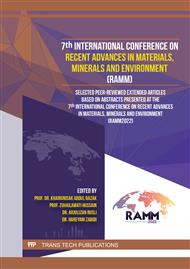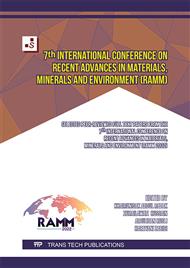[1]
N.N. Zulkarnain, S.A. Farhan, Y.A. Sazali, N. Shafiq, S.H. Abd Rahman, A.I. Abd Hamid, M.F. Habarudin, Reducing the waiting-on-cement time of geopolymer well cement using calcium chloride (CaCl2) as the accelerator: Analysis of the compressive strength and acoustic impedance for well logging, Sustainability 13 (2021) 6128.
DOI: 10.3390/su13116128
Google Scholar
[2]
F.I. Ismail, S.A Farhan, N. Husna, N. Shafiq, M.M. Abdul Wahab, S.N. Abd Razak, Influence of graphene nanoplatelets on the compressive and split tensile strengths of geopolymer concrete, IOP Conf. Ser. Earth Environ. Sci. 945 (2021) 012060.
DOI: 10.1088/1755-1315/945/1/012060
Google Scholar
[3]
S.N. Abd Razak, N. Shafiq, L. Guillaumat, M.M. Abdul Wahab, S.A Farhan, N. Husna, F.I. Ismail, Fire performance of fly ash-based geopolymer concrete: Effect of burning temperature, IOP Conf. Ser. Earth Environ. Sci. 945 (2021) 012062.
DOI: 10.1088/1755-1315/945/1/012062
Google Scholar
[4]
S.N. Abd Razak, N. Shafiq, L. Guillaumat, M.M. Abdul Wahab, S.A Farhan, N. Husna, F.I. Ismail, Effect of heating duration at high temperature on the strength and integrity of fly ash-based geopolymer concrete, IOP Conf. Ser. Earth Environ. Sci. 945 (2021) 012063.
DOI: 10.1088/1755-1315/945/1/012063
Google Scholar
[5]
S.H. Abd Rahman, S.A. Farhan, Y.A. Sazali, L.H. Shafiee, N. Husna, A.I. Abd Hamid, N. Shafiq, N.N. Zulkarnain, M.F. Habarudin, Effect of elastomeric expandable additive on compressive strength and linear expansion of fly-ash-based strength-enhanced geopolymer cement for shrinkage-resistant oil-well cementing, Appl. Sci. 12 (2022) 1897.
DOI: 10.3390/app12041897
Google Scholar
[6]
S.N. Abd Razak, N. Shafiq, L. Guillaumat, S.A Farhan, V.K. Lohana, Fire-exposed fly-ash-based geopolymer concrete: Effects of burning temperature on mechanical and microstructural properties, Materials 15 (2022) 1884.
DOI: 10.3390/ma15051884
Google Scholar
[7]
F.I. Ismail, S.A. Farhan, N. Shafiq, N. Husna, M.T. Sharif, S.U. Affan, A.K. Veerasenan, Nano-porous silica-aerogel-incorporated composite materials for thermal-energy-efficient pitched roof in the tropical region, Appl. Sci. 11 (2021) 6081.
DOI: 10.3390/app11136081
Google Scholar
[8]
M.F. Khamidi, C. Glover, S.A. Farhan, N. Husna, M.F. Nuruddin, Effect of silica aerogel on the thermal conductivity of cement paste for the construction of concrete buildings in sustainable cities, in: W.P. De Wilde, S. Hernández, C.A. Brebbia (Eds.), High Performance and Optimum Design of Structures and Materials, WIT Press, Southampton, UK, 2014, p.665–674.
DOI: 10.2495/hpsm140601
Google Scholar
[9]
BS EN 197-1: Cement. Composition, Specifications and Conformity Criteria for Common Cements, British Standards Institution, London, UK, 2011.
Google Scholar
[10]
ASTM C172: Standard Practice for Sampling Freshly Mixed Concrete, ASTM International, PA, USA, 2017.
Google Scholar
[11]
ASTM C192: Standard Practice for Making and Curing Concrete Test Specimens in the Laboratory, ASTM International, PA, USA, 2014.
Google Scholar
[12]
ASTM C109: Standard Test Method for Compressive Strength of Hydraulic Cement Mortars (Using 2-in. or [50-mm] Cube Specimens), ASTM International, PA, USA, 2020.
DOI: 10.1520/c0109_c0109m-99
Google Scholar
[13]
ASTM C496: Standard Test Method for Splitting Tensile Strength of Cylindrical Concrete Specimens, ASTM International, PA, USA, 2017.
Google Scholar
[14]
M. Abdul Rahim, N.M. Ibrahim, Z. Idris, Z.M. Ghazaly, S. Shahidan, N.L. Rahim, L.A. Sofri, N.F. Isa, Properties of concrete with different percentage of the rice husk ash (RHA) as partial cement replacement, Mat. Sci. Forum 803 (2014) 288–293.
DOI: 10.4028/www.scientific.net/msf.803.288
Google Scholar
[15]
M. Gesoglu, E. Güneyisi, A.H. Nahhab, H. Yazıcı, The effect of aggregates with high gypsum content on the performance of ultra-high strength concretes and Portland cement mortars, Constr. Build. Mater. 110 (2016) 346–354.
DOI: 10.1016/j.conbuildmat.2016.02.045
Google Scholar
[16]
F.S. Khalid, H.S. Herman, N.B. Azmi, Properties of sugarcane fiber on the strength of the normal and lightweight concrete, MATEC Web Conf. 103 (2017) 01021.
DOI: 10.1051/matecconf/201710301021
Google Scholar



